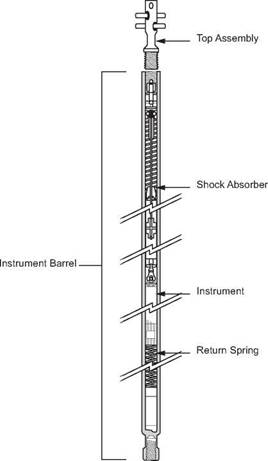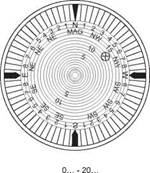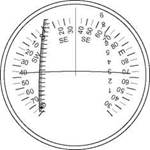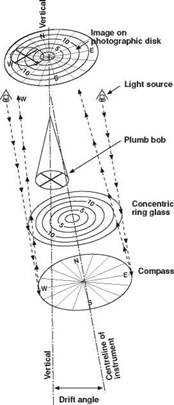 Magnetic Single Shot
Magnetic Single Shot
The magnetic single shot was first used in the 1930’s for measuring the inclination and direction of a well. The instrument consists of 3 sections:
• An angle unit consisting of a magnetic compass and an inclination measuring device.
• A camera section
• A timing device or motion sensor unit
The angle unit of the tool consists of a magnetic compass and a plumb bob (Figures 9 and 10). When the tool is in the correct position (near the bit) the compass is allowed to rotate until it aligns itself with the Earth’s magnetic field. The plumb bob
|
Ј |
|
|
|
|
|
Bumper Assembly |
hangs in the vertical position irrespective of how the instrument may be deviated in the hole.
Figure 9 Magnetic Single Shot Device
The camera consists of a photographic disc, which is mounted in the tool in a lightproof loading device, a set of bulbs which are used to illuminate the angle unit, when required, and a battery unit, which provides power to the light bulbs.
The timing device is used to operate the lightbulbs when the instrument is in the correct position. The surveyor must estimate the time required to lower the instrument into position and set the timer accordingly. Since it is sometimes difficult to estimate the time required for the tool to reach the bit, more modern instruments
|
|
|
Inclination = 12… Direction = N 60. W |
|
Inclination = 33. Direction = S 36. E 15. — 90. |
|
|
|
Inclination = 5. Direction = N 65. W |
|
0. — 10. |
|
Figure 11 Examples of Compass Displays |
use a motion sensor unit. This electronic device will illuminate the lightbulbs when the instrument stops moving. When the lightbulbs are illuminated a photograph image of the plumb bob is superimposed on the compass card as shown in Figure 11.
|
Figure 10 Magnetic Single Shot Instrument |





